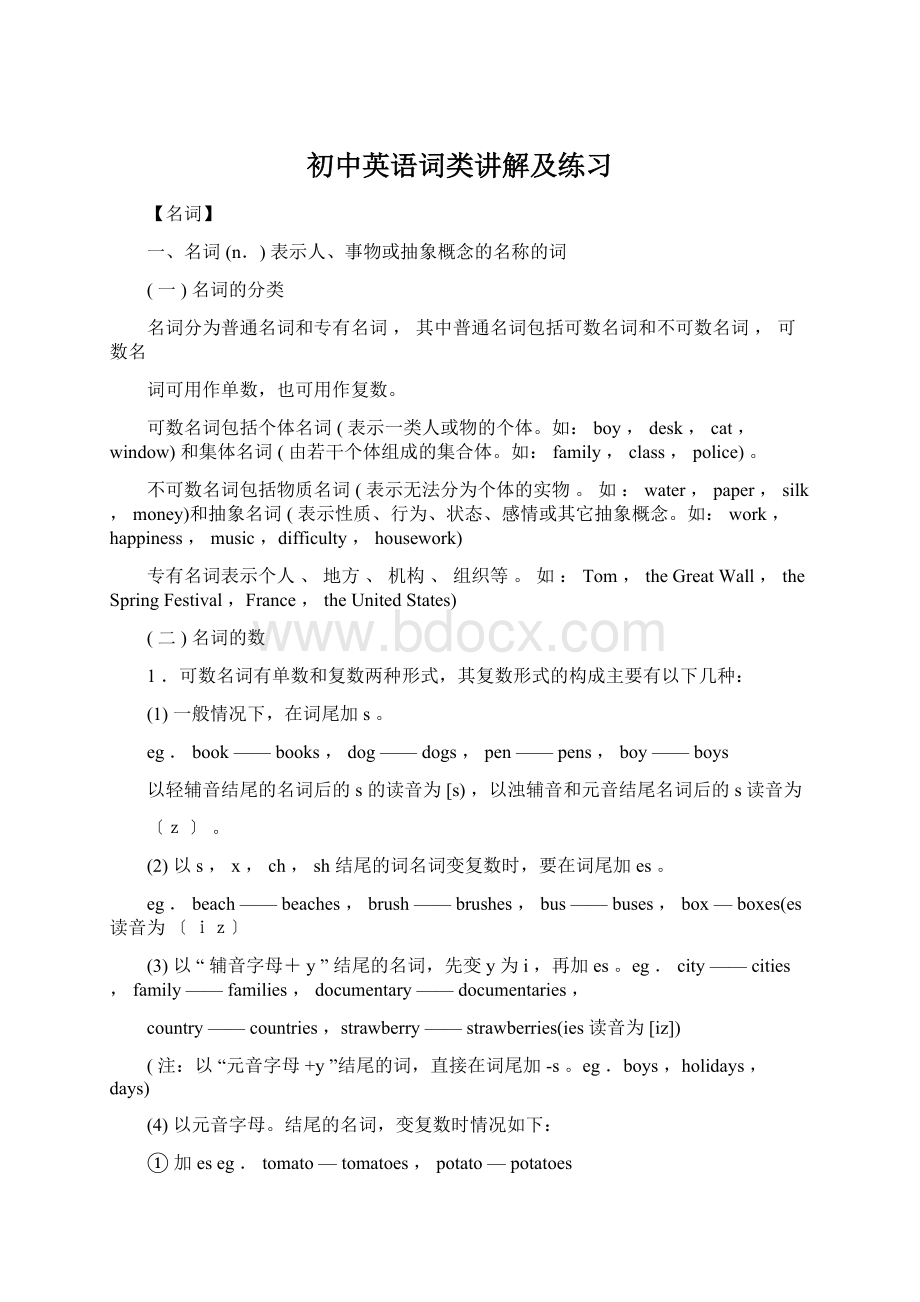初中英语词类讲解及练习Word文件下载.docx
《初中英语词类讲解及练习Word文件下载.docx》由会员分享,可在线阅读,更多相关《初中英语词类讲解及练习Word文件下载.docx(22页珍藏版)》请在冰豆网上搜索。

(4)以元音字母。
结尾的名词,变复数时情况如下:
①加eseg.tomato—tomatoes,potato—potatoes
②结尾是两个元音字母的加s,eg.ZOO—zoos,radio——radios
③某些外来词变复数时词尾加s,eg.piano—pianos
④一些名词的缩写形式变复数时,词尾加s,
eg.photo(photograph)——photos,kilo(kilogram)kilos
⑤zero变复数时,既可加s,也可加eseg.zeros/zeroes
(5)以f或fe结尾的名词变复数时,先把f或fe变为v,再加es。
eg.wife——wives,leafleaves,half——halves,knife—knives,thief--thieves(ves读音为[vz]
(注意:
roof的复数为roofs;
scarf的复数为scarfs/scarves)
(6)有些名词由单数变复数时,不是在词尾加s或es,而是变换其中的字母,
eg.man——men,woman——women,policeman——policemen,
Englishman——Englishmen,Frenchman——Frenchmen,foot——feet,tooth——teeth,child——children,mouse—mice,Ox—Oxen(公牛)
(7)还有一些名词的单数和复数形式相同。
eg.Chinese,Japanese,sheep,deer,fish
(8)另一些名词本身即是复数形式,不可用作单数。
eg,people,police,trousers,pants,clothes,scissors
另外,①当一个名词作定语说明另一个名词时,这个名词一般用单数。
eg.anappletree,fiveappletrees,agirlfriend,twogirlfriends,atwinsister
但是,当man和woman作定语修饰复数名词时,就要用其复数形式。
eg.twomenteachers,threewomendoctors
②可用“量词+of+名词复数”这一结构表示可数名词的数量。
eg.aroomOfstudents,twoboxesOfpencils
2.不可数名词一般没有复数形式,它的“量”的表示方式如下。
(1)表不定数量时,一般用much,(a)little,alotof/lotsof,some,any等词修饰。
eg,muchmoney,alittlebread
(2)表确定数量时,一般用“数词+量词+of+不可数名词。
two/three/…+量词复数十of+不可数名词。
eg.abagOfrice,twoglassesOfmilk,fourbottlesOfwater
3.有些名词既可作可数名词也可作不可数名词,但词义有所不同。
eg:
fruit水果——fruits表示不同种类的水果;
food食物——foods各种食品;
fish鱼——fishes鱼的种类;
drink饮料、酒——adrink一杯/一份饮料、一杯酒;
cloth布——acloth桌布、抹布;
sand沙——sands沙滩;
tea茶——atea一杯茶;
chicken鸡肉——achicken小鸡;
orange橘汁——anorange橘子;
glass玻璃——aglass玻璃杯,glasses眼镜;
paper纸——apaper试卷、论文;
wood木头——awood小森林;
room空间、余地——aroom房间
(三)名词的所有格(表示人或物的所属关系)
(1)有生命的名词所有格以及表示时间、距离、城镇、国家等的名词所有格。
①不是以s结尾的名词变成所有格时,在词尾加’s。
eg.Mike’swatch;
Women’sDay
②以s结尾的名词变成所有格时,只加’。
eg.teachers’office,students’rooms
③两个或两个以上名词并列,表示共同所有,只需在最后一个名词后加’s。
eg.TomandMike’sroom汤姆和迈克的房间(表示汤姆和迈克共有一间房)
④两个或两个以上名词并列,表示分别所有,需在几个名词后都加’s。
eg.Mary’sandJenny’sbikes玛丽和詹妮的自行车(表示玛丽和詹妮各自的自行车)
(2)无生命的事物的名词所有格常用of结构
eg.amapOfChina,thebeginningOfthisgame,thedoorOftheroom
(3)特殊形式
①可用’s和of短语表示的名词所有格
eg.theboy’sname=thenameOftheboy(男孩的名字)
thedog’slegs=thelegsofthedog(狗的腿)
China’spopulation=thepopulationOfChina(中国的人口)
China’scapital=thecapitalofChina(中国的首都)
②双重所有格
eg.afiendofmymother’s我妈妈的一个朋友
apictureofTom’s汤姆的一张图片
名词练习题
名词复数
一、选择填空
()1.Icanseethree________inthezoo.Amonkeys
BmonkeyesCmonkey
()2.Thepighasfour______. A.foot B.feet C.foots
()3.Mytwobrothersareboth______.A.policeman B.policemans C.policemen
()4.Icanseeten_____inthepicture. A.sheep B.dog C.pig
()5.The_____hasthree______. A.boys,watches B.boy,watchC.boy,watches
()6.Canyousee_______ontheplate?
A.bread
B.breads
C.breades
()7.Thegirloftenbrushesher___beforeshegoestobed.A.toothB.toothsC.teeth
()8.MrBlackoftendrinksome_________.A.milk
B.milks
C.milkes
()9.Therearesome_____onthefloor. A.childB.waterC.books
()10..Lucywillshowussomenew____ofhers. A.photoB.photosC.photoes
()11.Idranktwo______.A.bottlesofwater B.bottleofwater C.bottlesofwaters
()12.Thecateatstwo_____lastnight. A.mouses B.mice C.mouse
()13.Ineedapenandsome_____. A.books
B.deskC.chair
()14.Theresomeintheriver.
A.is,fishB.are,fishsC.is,fishsD.are,fish
()15.Theretwointhebox.
A.iswatchB.arewatchesC.arewatchD.iswatches
二、用所给的单词的复数的正确形式填空:
1.Therearethree______(child)intheclassroom.
2.These_______(tomato)arered.
3.Ihavetwo______(knife).
3.Mybrotherlooksaftertwo______(baby)
5.Myfatherlikestoeat_______(potato).
6.Therearesome______(leaf)inthestreet.
7.Chinese______(people)liketoeatnoodles.
8.Ihavealotof______(toy)inmybedroom.
9.Ihelpmymotherwash______(dish)inthekitchen.
10.Therearetwohundred______(womanteacher)inourschool.
名词的格
用所给词的适当形式填空:
1.March8this__________Day.(woman).
2.Takingtwenty__________(分钟的)exerciseeverydayisgoodforyourhealth.
3.Teachersinwesterncountrieshavea__________(三个月的)holidayinayear.
4.I’llgivemyEnglishteacheracardfor____________Day.(teacher)
5.It’san__________(hour)ridefromheretothemuseum.
选择填空:
1.----How’sJoy’sskirt?
----Herskirtismorebeautifulthan________.
A.hersister’sandKate
B.hersisterandKate
C.hersisterandKate’s
D.hersister’sandKate’s
2.Thisis_______room.Thetwinsisterslikeitverymuch.
A.Lucy’sandLily’s
B.Lucy’sandLily
C.LucyandLily’s
3.Wewillhavea___________holidayaftertheexam.
A.twomonth
B.two–month
C.twomonth’s
D.two–months
4.It’sabout__________walkfrommyhome.
A.tenminute
B.tenminutes’
C.tenminute’s
D.tenminutes
5.Thisismydress.Thatoneis______________.
A.Mary
B.Mary’s
C.sister
D.mother
6.__________mothersmadethemhavepianolessons.
A.PeterandAnne
B.Peter’sandAnne’s
C.Peter’sandAnne
D.PeterandAnne’s
7.Theroomontherightis________.
A.her
B.she
C.Lucy’s
D.Lucy
8.Themarketisn’tfarfromhere.It’sonly___________bicycleride.
A.halfanhours’
B.halfanhour’s
C.halfanhour
D.anhourandahalf
9.Where’syourfather?
At_________.
A.MrGreen’s
B.Mr.Green
C.theMr.Green’s
10.Wherehaveyoubeenthesedays?
IhavebeentoBeiDaihewithafriend__________.
A.inChinese
B.ofJapan
C.ofAmerican’s
D.fromCanada
11.Katewonthe_______raceinthesummersportsmeeting.
A.100-metre
B.100-metres
C.100metre
D.100metre’s
12.I’llgiveyou________tofinishthework.OK.
A.twoweek’stime
B.twoweeks’time
C.twoweektime
D.twoweekstime
13.Isthisyourroom?
No,it’s_________room.
A.thechildren
B.thechildren’s
C.ofthechildren
D.thechildrens’
14.Whoisthemaninthebluecar?
Heis__________father.
A.Kate’sandMary’s
B.KateandMary’s
C.KateandMary
D.ofKateandMary
【代词】
人称代词,物主代词,反身代词
类别主格宾格形容词性物主代词名词性物主代词反身代词
第一人称单数Imemyminemyself
复数weusouroursourselves
第二人称:
单数youyouyouryoursyourself复数youyouyouryoursyourselves
第三人称:
单数hehimhishishimselfsheherherhersherselfitititsitsitself
复数theythemtheirtheirsthemselves
1.人称代词
人称代词it的特殊用法:
一般it指“它”,但在表示天气、时间、距离等时,用it来代替,此时的it并不译为“它”。
当三个人称代词(单数)同时出现时,其先后顺序为you,he,I。
而复数一般采用we,you,they顺序。
2.物主代词物主代词的用法:
形容词性物主代词后面一定要跟上一个名词。
名词性物主代词可作主语、表语、宾语。
3.反身代词
1)反身代词的构成分两种:
第一、二人称反身代词在形容词:
性物主代词后加上self或selves,第三人称的反身代词在宾格代词后加上self或selves.
2)反身代词的用法:
一种是作宾语,由主语发出的动作又回到动作者本身。
Ienjoyedmyselfattheparty.另一种是作名词或代词的同位语;
用来加强语气。
Icandoitmyself.
3)初中阶段由反身代词构成的常用词组有:
enjoyoneself,helponeselfto,learnbyoneself,teachoneself,(all)byoneself,leave...byoneself,loseoneselfin等,在运用反身代词时,应注意它在数、性别上与哪一个保持一致。
试比较:
“Helpyourselvestosomefish,TomandMike.”与Ican’tleavethegirlbyherself.
指示代词
指示代词的特殊用法:
(1)为了避免重复,可用that,those代替前面提到过的名词,但是this,these不可以。
(2)this,that有时可代替句子或句子中的一部分。
不定代词主要不定代词的用法:
(1)one的用法:
A.one作为代词可以指人,也可以指物。
B.one,ones(one的复数形式)可用来代替前面出现过的少数名词,以避免重复。
C.one的前面可用this,that,the,which等词来修饰。
D.常有a+形容词+one这一形式。
it和one的用法区别:
it用来指特定的东西,而one则用于替代不特定的东西。
(2)some和any的用法区别
A.some,any可与单、复数可数名词和不可数名词连用。
some一般用于肯定句,any一般用于否定句,疑问句和条件句中。
B.some,any与—thing,—body,—one构成的合成词的用法与some,any一样。
C.在疑问句中,一般不用some,只有当问句表示一种邀请或者请求,或期待一个肯定的回答时才能用some。
D.some在否定句中表示半否定,any表示全否定。
E.some用于单数可数名词前,表示“某个”而不是“一些”。
(3)other,another的用法
数种类单数复数
泛指another=anotherother(boys)others
特指theothertheother(boys)theothers
功能作主语、宾语、定语、作定语、作主语、宾语
A.another=another"
另一个”,泛指众多者中的另一个,在原有基础上自然增加的另一个。
一般后面接单数名词,前面不能加定冠词。
有时another可以用在复数名词前表示“又”“再”,如:
Iwanttohaveanothertwocakes.我想再吃两个蛋糕。
B.theother表示两个中的另一个,常与one连用。
常见形式是“one...theother...”。
C.other+复数名词=othersD.theother+复数名词=theothers
(4)a11、both的用法
both表示“两者都……”,而a11表示“三个或三个以上的人或物都……”。
a11、both在句中放在be动词,情态动词及助动词之后,放在实义动词之前。
(5)each和every的用法
A.each用来指两个或两个以上的人或物中的一个。
every则指两个以上的人或物中的一个。
B.从含义和语法功能上看,each是“单个”的意思,侧重个体,在句中可作主语、同位语、定语和宾语。
而every是“每一个”之意,侧重全体、整体、共性。
在句中只能作定语,也就是说它后面必须跟着名词。
而由every构成的合成词后面绝不能跟名词。
(6)either,neither,both的用法
either:
指两者中的任意一个。
作主语谓语用单数。
neither:
指两者都不,全否定。
both:
指两者都。
作主语谓语用复数。
(7)many和much
many只能和复数可数名词连用。
much只能和不可数名词连用。
注意:
alotof/lotsof/plentyof=much/many
alarge/greatnumberof=manyagreat/gooddealof=much
(8)few,afew,little,alittle
few,little表示否定含义,“很少”“几乎没